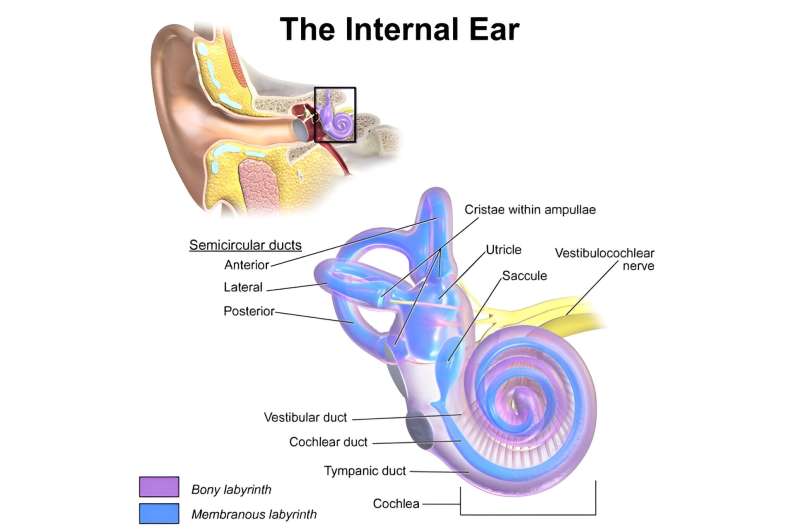This article has been reviewed according to Science X's editorial process and policies. Editors have highlighted the following attributes while ensuring the content's credibility:
fact-checked
proofread
Study finds volume changes of inner-ear endolymphatic compartments in Ménière's disease

Elaborate 3D analysis of the inner ear provides insights into volume changes of special structures in sufferers of the so-called Ménière's disease, which leads to severe balance disorders and other problems. The cause of this rare disease remains unclear.
A successful collaboration between the Karl Landsteiner University of Health Sciences (Krems, Austria) and Harvard Medical School and Johns Hopkins University (both U.S.) has now provided new insights into the disease process. The work is published in the journal Otology & Neurotology.
Using 3D-reconstructions of inner ears (based on anatomical slices) the international team was able to measure for the first time altered volumes of structures known as endolymphatic compartments in patients with the disease. A connection with the thickness of special membranes in the inner ear was also identified. In addition, further evidence was found concerning the functioning of a poorly understood structure in the inner ear (Bast's valve).
Ménière's disease causes nausea, spinning dizziness, tinnitus, and hearing loss. As rare as the disease is, so difficult is its treatment. In extreme cases, the vestibular nerve must be severed, or the vestibular organ surgically removed. For milder cases, antibiotic treatment has proven effective. This was confirmed by the team of the Karl Landsteiner University of Health Sciences (KL Krems) five years ago, despite an unexplained mechanism of action.
The site of origin of the disease is the organ of equilibrium in the inner ear where, according to the latest findings of KL Krems, a pressure increase occurs in the case of disease. The effect on the endolymphatic compartments of the inner ear has now been looked at in detail by the team.
3D inner ear
In addition to the cochlear duct, important parts of the inner ear include the cavernous extensions at the outer end of the cochlear duct known as sacculus and utriculus. The research team, led by Dr. Béla Büki, Krems University Hospital (education and research site of KL Krems), compared inner ears of nine Ménière's patients with those of 10 healthy individuals. For this, digital 3D models were created on the basis of numerous anatomical slices. These were then used to determine the volumes of the above-mentioned compartments as well as the thickness of special membranes (Reissner's membrane) and also the condition of the so-called Bast's valve.
Commenting on the results, which were obtained with colleagues from Harvard Medical School and Johns Hopkins University, Dr. Büki says, "Very often, the volume of the external cochlear duct as well as the one of the sacculus was enlarged in affected patients. We were able to clearly demonstrate this in the virtual 3D models." Furthermore, the evaluations showed that the volume of the utriculus had also increased in numerous—but less—affected individuals.
Due to the detailed analysis of the inner tubes, the team was subsequently able to measure the thickness of the membranes lining the respective compartments. "The thickness of this membrane," explains Dr. Büki "forms a mechanical resistance to the increase in pressure of the inner ear fluids known as endolymph, which we demonstrated in a previous paper. This, in turn, affects volume changes."
And indeed, the membrane thicknesses fit perfectly with the analyzed volumes of the compartments. In healthy subjects, Reissner's membrane of the utriculus was thicker compared with that of the (outer) cochlear canal, as well as that of the sacculus—which could prevent volume expansion when endolymph pressure is increased. This would explain the observation that the utriculus was less frequently dilated.
But then, why was volume dilation of the utriculus nevertheless detectable in some affected individuals? Further analysis of the so-called Bast's valve, a valve at the entrance to the utriculus, provided answers to this question. In fact, in all cases of Ménière's disease in which the utriculus was also swollen, Bast's Valve was open, or the surrounding membrane was ruptured. This suggests a pressure-regulating function of the valve. This is an invaluable observation, considering that the exact function of this valve remains unclear nearly 100 years after its discovery.
More information: Béla Büki et al, Differential Volume Increase of Endolymphatic Compartments in Ménière's Disease Is Inversely Associated With Membrane Thickness, Otology & Neurotology (2023). DOI: 10.1097/MAO.0000000000003960

















